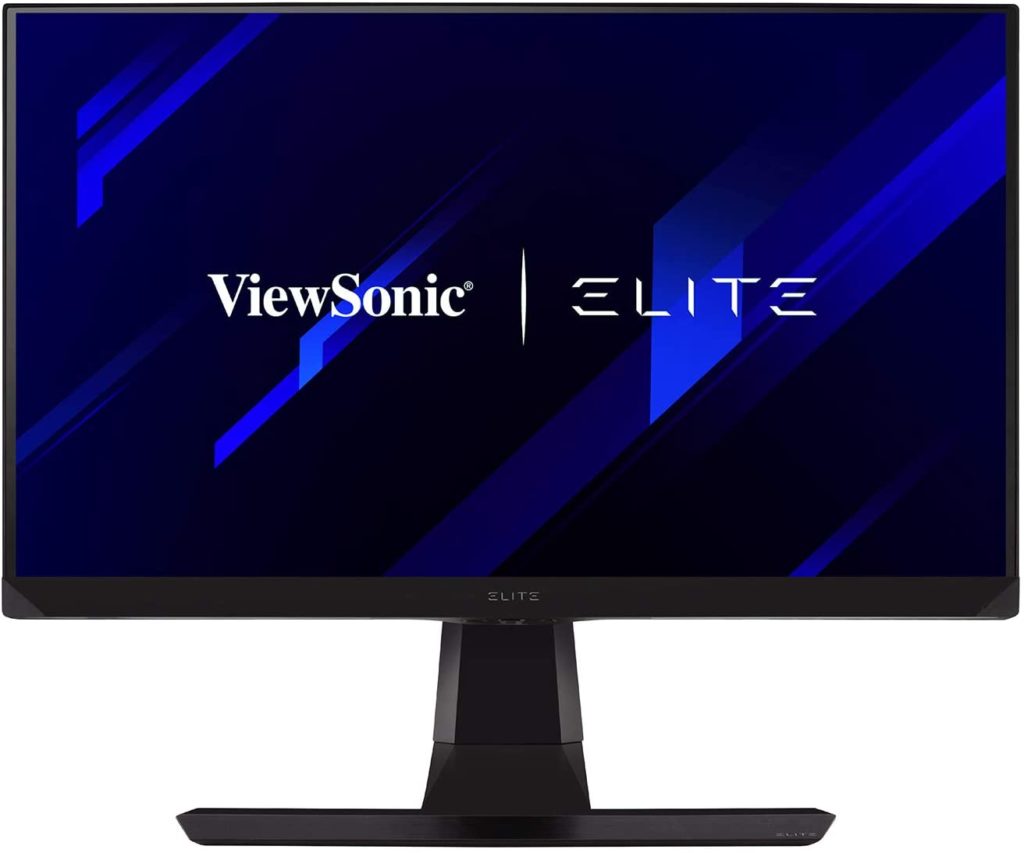
The ViewSonic XG270 is a fantastic gaming monitor that offers attractive features such as its 240Hz IPS panel and native G-Sync compatibility. The monitor offers an upgrade in color fidelity while providing you with impressive smoothness and lucidity. The 240Hz IPS segment is rapidly growing and becoming highly competitive, so let’s check out if the ViewSonic XG270 comes out at the top.

ViewSonic XG270 Specifications
- Screen Size: 27 Inches
- Resolution: 1920 x 1080 FHD
- Aspect Ratio: 16:9
- Panel Technology: In-Plane Switching (IPS)
- Refresh Rate: 240Hz
- Response Time: 1ms
- Contrast Ratio: 1000:1 (Static)
- Brightness: 400 cd/m²
- Built-in Speakers: Yes (2 x 3 Watts)
- Stand: Height – Yes
- Stand: Tilt – Yes
- Stand: Swivel – Yes
- Stand: Pivot – Yes
- VESA Compatibility: Yes (100 x 100)
- Connectivity: DisplayPort 1.2 x 1, HDMI 2.0 x 2, USB 3.0 x 4, 3.5mm Jack x 2
- Dimensions with Stand (W x H x D): 24.2” x 22.5” x 10.4”
- Weight: 16.1 lbs

Design and Features
The ViewSonic XG270 shares the same aesthetic with the XG270QG, but with a faster, yet lower resolution IPS display. The device has a matte black chassis which looks more premium than older models from the brands which usually had red streaks. The display is bezel-free on three sides which makes this model ideal for dual or triple monitor setups.
The ViewSonic XG270 has an RGB lighting feature shaped into a hexagon at the back, surrounding its VESA attachment point. The LEDs are bright enough to cast a bias light if you have a monitor close to a wall to help keep your eyes comfortable during extended use. ViewSonic is part of the RGB alliance, so the lighting can be controlled with popular ecosystems such as Razer’s Chroma or Coolermaster’s MasterPlus+.
This model also comes with anti-glare flaps which you can attach to the sides of the display if in case you play in a well-lit room. Its usefulness is always down to user preference, but it having them with the kit extends the value of the monitor. It’s also worth noting that they fold outwards if in case you don’t need them which is handy compared to removing them and attaching them again when necessary.
Build quality is outstanding on the ViewSonic XG270, so you don’t have to worry about physical defects or it breaking down after some time. The plastics used feel sturdy enough to withstand some force, plus the monitor stands stable once propped up on your desk. There are no uneven seams or sharp edges on the chassis thanks to well-implemented quality control from the manufacturing process.
The ViewSonic XG270 has a fully ergonomic stand that offers tilt, swivel, pivot, and height adjustments. Attaining a perfect viewing angle is easily doable, so you won’t need to spend the extra for a VESA mount. However, the ViewSonic XG270 is compatible with arms that have a 100 x 100 adapter if you wish to do so.
One thing we love about the ViewSonic XG270 is its control layout which is located at the center of the bottom bezel. The multi-directional joystick makes browsing and selecting options from the OSD a breeze, unlike buttons that are often confusing to use. It’s also great that it’s located closer to the user so they don’t have to reach for the back of the monitor’s housing.
Some might want to consider VESA mounts since the ViewSonic XG270’s stand is quite large, requiring almost 11 inches of depth on a desk. The T-shaped base also takes up a considerable amount of space upfront, so users with several peripherals such as stream decks and docks might have to make do without this part. However, you do get excellent stability with it, so we think its still a fair trade-off.

The ViewSonic XG270 has a sufficient amount of connectivity features for almost everything you will need with a gaming setup. The video inputs include a DisplayPort 1.2 slot along with two HDMI 2.0 slots that can accommodate a PC and up to two consoles. You will also find four USB 3.1 slots for peripherals, provided that the type-B upstream port is connected to your PC.
There is also a pair of 3-watt speakers which aren’t particularly groundbreaking, but they do sound better than the XG270QG’s set. Built-ins typically don’t sound good, but the pair ViewSonic used is a massive improvement over what some brands offer on their models. They sound good enough for videos and music, but most will still prefer headsets which will enable them to focus better on games.
Display and Performance
The ViewSonic XG270 sports a 27-inch IPS panel with a 1920 x 1080 resolution, 240Hz refresh rate, and a boosted 1ms response time. The backlight is rated at 400 cd/m2, while the contrast ratio is listed at a typical 1000:1 like most IPS variants. The XG270 is compatible with HDR, but it doesn’t have the necessary hardware to provide a full experience.
Full HD at 27 inches isn’t popular by opinion due to its lower pixel density, but user feedback suggests otherwise. Visibility which is far more important in competitive games than sharp eye candy is improved, enabling the gamer to spot small objects easier. Reading walls of text are also more comfortable for the eyes since you don’t have to squint often to see small fonts.
The ViewSonic XG270 doesn’t have an extra-wide gamut coverage since it’s limited to 98% of the sRGB color space. Color accuracy isn’t perfect as well, with errors having a DeltaE average of 2.9. That’s still within acceptable limits, but calibration is necessary for a more balanced image or if you are also planning to use the monitor for editing or content creation.
Adjusting a few settings on the ViewSonic XG270 will give you a much better color DE of 0.6 which is within the range of professional displays. You also get a color temperature that isn’t as warm as the default setting which often makes white backgrounds too yellowish. This can be achieved by dropping the red color temp in the OSD a few notches and setting a brightness level of around 30 to 40%.
The ViewSonic XG270’s contrast is good as far as IPS panels go at 1070:1 when the backlight is set to our recommended level. Unfortunately, it isn’t enough to upgrade the monitor’s black luminance which is quite high, resulting in grayish blacks. Gamma, on the other hand, behaved within margin or error between the factory and calibrated settings, with both results sitting very close to the ideal 2.2.
Panel uniformity on the ViewSonic XG270 is a huge concern since its blacks have a few clouding spots on the display’s corners. This flaw doesn’t affect most games, but titles with dark scenes might show different results. Take note that this aspect varies between every due to manufacturing tolerances, especially IPS panels.
The ViewSonic XG270 has one of the best motion handling capabilities in its segment since it practically doesn’t have blurring issues. Setting the monitor’s overdrive to its Faster setting at 240Hz is best at cleaning up the minor trails on-screen without overshoot. Backlight strobing isn’t necessary with this model thanks to a very effective overdrive function.
The ViewSonic XG270 is compatible with both FreeSync and G-Sync, enabling users of both brands to enjoy buttery smooth gaming. Going with a monitor that works with both implementations is practical since you are not stuck with one brand when the time to upgrade comes. Input lag sits at a little over 2ms at 240Hz, so there is no need to worry about de-synced instances or delays while playing competitively.
Thoughts on the ViewSonic XG270
The ViewSonic XG270 is an excellent option if you want one of the most responsive gaming monitors for competitive gaming. Its motion handling and low latency make it an excellent pick for E-Sports gamers who want a blur and delay-free gaming experience. The monitor also features a very attractive design and both FreeSync and G-Sync compatibility, making it an ideal centerpiece for your battle station.
The only things that plague the ViewSonic XG270’s greatness are its factory default image quality and limited contrast ratio. Thankfully, it’s easy to get around that issue if you know your way around a monitor’s OSD. It’s overall an excellent choice, but options like the Asus VG279QM are faster and more color-accurate out of the box.
Pros:
- Attractive Design with Nifty Extras
- Fast and Responsive; No Need for Strobing
- Low Input Lag
- FreeSync and G-Sync Compatible
Cons:
- Pricey
- Limited Contrast
- Uniformity Needs Improvement
- Poor Calibration Out of the Box
About the Author:


Paolo is a gaming veteran since the golden days of Doom and Warcraft and has been building gaming systems for family, friends, and colleagues since his junior high years. High-performance monitors are one of his fixations and he believes that it’s every citizen’s right to enjoy one. He has gone through several pieces of hardware in pursuit of every bit of performance gain, much to the dismay of his wallet. He now works with Monitornerds to scrutinize the latest gear to create reviews that accentuate the seldom explained aspects of a PC monitor.
Leave a Reply